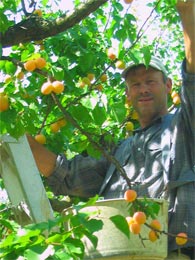A Little Apricot History
- By FruitGuys Staff
- Last Updated On
- Reading Time: 3 mins.
 from Good Humus Produce, courtesy of Capay Valley Farm Shop
from Good Humus Produce, courtesy of Capay Valley Farm Shop
A combination of Royal and Blenheim Apricots From the Luxemburg Gardens in Paris to England’s Blenheim Palace to the imperiled orchards of Brentwood and Gilroy, California’s finest apricot has had a long journey. Whether you call it the Blenheim, the Royal or, covering all bases, the Royal Blenheim, this petite but sublime variety, compensates with great taste for what it lacks in good looks.
Other apricots are huge and bright orange, and “I’d rather eat a cotton ball,” says Andy Powning, produce specialist for Greenleaf Produce in San Francisco. During the few fleeting weeks in early summer when the Royal Blenheim appear in the markets, many consumers eye their small size and green shoulders and pass them by. But knowledged shoppers know that they’re the best eating cots in the market and superb for jam and desserts. What many might not know is that the Royal Blenheim is a vanishing fruit, hammered by foreign competition and its own finicky nature.
Blenheim’s tangled genealogy. One theory traces it back to a seedling planted in the Luxembourg Gardens and introduced to the public around 1815 under the name Royal. About 20 years later, the daughter of the head gardener at Blenheim Palace, a man named Shipley, planted a seed said to be from the Royal. The tree thrived and its fruit was called Shipley’s Blenheim.”¨So the Royal comes out of France, and Shipley’s Blenheim comes out of England, and they probably have some shared bloodline. Both varieties made it to California by the 1880s and entered the commercial nursery trade. During World War 1, when shipments of dried fruit from Europe came to a halt, demand for apricot trees in California spiked. Nursery growers, in their haste to fill orders, failed to maintain the varieties’ integrity and shipped whatever they had. The names Royal and Blenheim have been used indiscriminately ever since.
Want farm-fresh fruit?
We've got you covered.
The intensely flavored Royal Blenheim became the preference in California drying yards with the result that by the 1920’sthis variety blanketed the Santa Clara and Alameda counties and the Sacramento Valley. By the end of the 20th century, most of these orchards have been turned into office parks and tract homes. For the few remaining Royal Blenheim growers, the dried fruit market has all but collapsed with the growing dominance of cheaper Turkish dried apricots. For the fresh market Royal Blenheim growers, the choices are few. They can try to sell the variety on the fresh market, a difficult proposition, they can replace the trees with newer varieties that are easier to market fresh, or they can throw in the towel.
The finicky nature of the Royal Blenheim is that they are so delicate, it is almost impossible to put them in the fresh market. The fragile fruit practically bruises at a glance, but packing them into cushioned trays used for peaches would make them prohibitively costly. The apricot ripens from the inside out causing fruit pickers to develop specific harvesting habits for the apricot that included picking fruits that still had a faint green tinge. The revival of the Blenheim is happening at local farmers markets where long-distance shipping is not a critical issue. “A lot of people don’t think they are ripe. You can always tell a Royal Blenheim because it has a greenish tint to it. It’s a hard sell when you have the newer varieties that are huge and have that pretty red blush on them” says Michele Bera an apricot farmer from Winters. Jan and Peter Wolfe have planted many of these modern types of apricots at their Ranch, but admit that the Royal Blenheim is the best tasting apricot and that they have never found its equal for pie or jam.
The Royal Blenheim Apricot is one of the fruits that The Slow Food International has put on the Ark, being an heirloom fruit that is worth saving for future generations, but it is on its way to becoming a backyard fruit, perhaps, and the exclusive province of niche growers, as it is being replaced by the other newer varieties that have been developed for the early market, that taste like cardboard and are turning people from eating apricots entirely.
Want farm-fresh fruit?
We've got you covered.Recent Articles
8 Avocado Varieties To Try (And When to Taste Them!)
When to Send Snack Care Packages to Employees: An HR Guide
The FruitGuys Delivers Fresh Groceries to 200 Federal Workers
Work Better With KiZE Bars: Clean-Ingredient Office Treats That Give Back
Farm-Fit Brings Fresh, Locally Sourced Produce to Campus
Subscribe to our Newsletter
"*" indicates required fields



